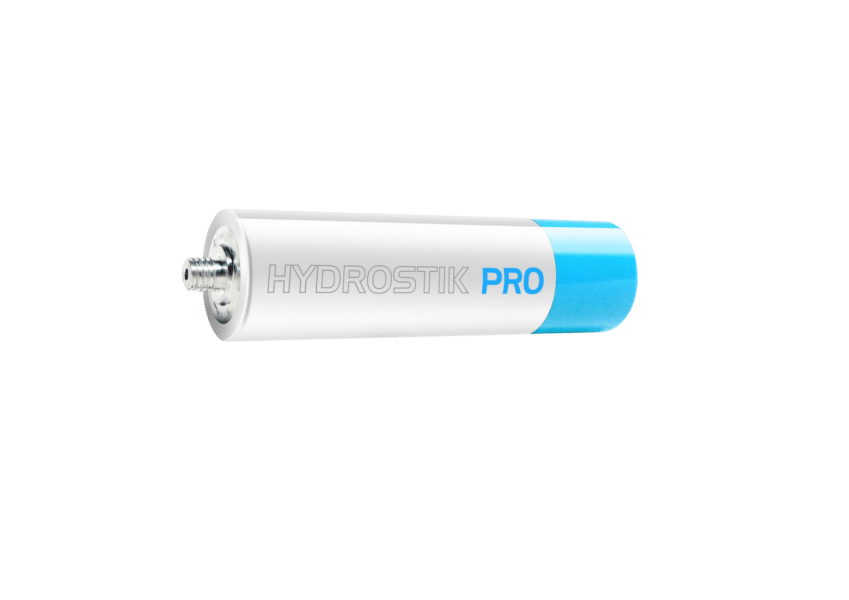Description
HYDROSTIK Pro
HYDROSTIK PRO Cartridge is designed with an aluminum alloy materials enclosure and a AB2 alloy for hydrogen absorption.
After activation, the AB2 alloy is capable of absorbing hydrogen, expanding and releasing heat until saturation. The internal pressure of the fully charged cartridge remains at 30Bar (435PSI) at ambient temperatures of 20˚C – 25˚C and the weight is around 0.9 gram higher. Once the cartridge valve is opened and pressure is reduced, hydrogen will be continuously released from the alloy that will absorb heat. If the heat absorption rate decreases, so will the hydrogen release rate. The cartridge enclosure materials are made of an aluminum alloy that has excellent heat conductivity properties that can facilitate heat conduction of the alloy during gas absorption and release processes. Gas absorption efficiency of the alloy can be significantly impacted by oxidization due to humidity; therefore dry hydrogen gas with a purity of no less than 99.99% is required for charging use.

Portable Hydrogen
Some technologies naturally capture the imagination. The high-end automotive industry, not-for-profit charities, space exploration – in very different ways all these sectors are dynamic and exciting, evoking the kinds of associations and images that professional marketers in more run-of-the-mill industries take years to cultivate. Renewable technology is this kind of sector. It’s not hard to get people excited about hydrogen as a clean, efficient technology that can run cars, buses, planes, power plants and even space rockets.
Well that’s great for us, obviously, and all major producers of hydrogen technology. But while we’re privileged to be working alongside leading innovators making truly impressive machines, sometimes it’s worth remembering the smaller innovations, the ones that are here, right now, making a tangible difference to the way people live.
Portable energy is the perfect example. The aim is to create longer-lasting power sources through manufacturing processes that produce barely a fraction of the greenhouse gas emissions of the traditional lithium batteries. Hydrogen cartridges can be stored for much longer without a noticeable drop in performance, they are safer as the hydrogen can be stored in solid state inside the casing, and they can be refilled quickly and easily.
Camping trips with consumer electronics? A full extra charge for smartphones and tablets for business travelers used to long trips without access to mains electricity? Fueling stations to refill hydrogen cartridges that require only distilled water to create hydrogen through electrolysis? Well, all this technology already exists, and every passing year brings new developments – longer periods between recharging, smaller cells that are easier to store, more powerful Hydropaks that can run productivity devices.
A single Hydrostick cartridge is capable of delivering ten hours of power at continuous consumption of 1W, and can be recharged up to 100 times. In conjunction with a hydrogen refueling station, Hydrostiks are therefore the equivalent of 1000 disposable AA batteries. Used Hydrostiks can either be exchanged for full cartridges or refilled using Horizon’s Hydrofill– an on-demand refueling station that produces hydrogen from distilled water.
Horizon already works with a number of leading brands in portable power. A partnership with Boc Industrial Gases resulted in the Hymera DC– a standalone unit that automatically monitors and recharges batteries. The Hymera is used for security cameras, electrified fences and backup power for IT and communication systems. Horizon cooperates with Air Liquide on a range of portable power products distributed as an internal promotion tool. Then the Brunton Hydrogen Reactor builds on Horizon’s Minipak to provide a portable recharging system for various electrical devices such as smartphones, tablets, GPS devices, cameras, MP3 players and flashlights.
Sometimes it’s the small changes that really drive a shift in consciousness. When hydrogen becomes a viable alternative for all those little, day-to-day activities – suddenly those cars, buses planes and rockets will seem like the natural next step rather than a far distant future.







